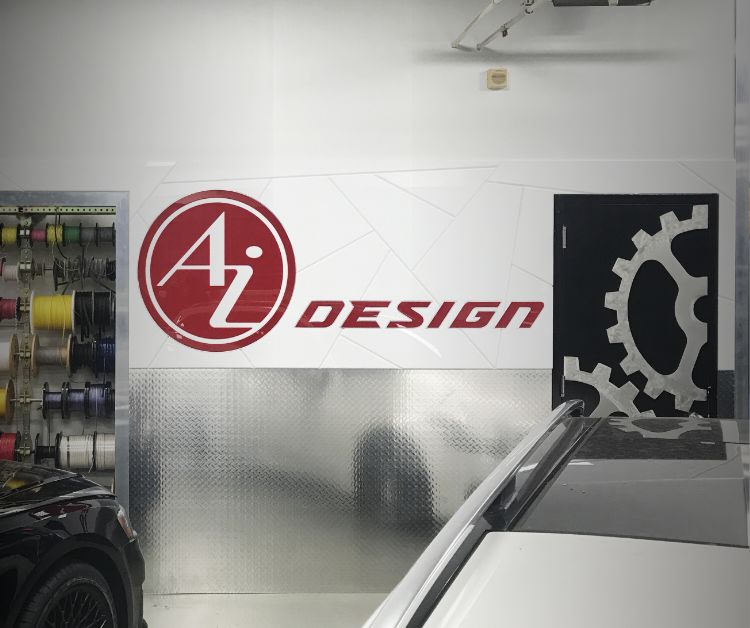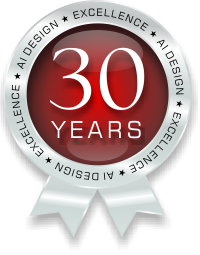Ai Design Blog
Mercedes 220S : Adding cool air to a cool car
Our client, who is a very notable collector with incredibly high standards, wanted to retrofit air conditioning on his beloved Mercedes-Benz 220S. Without doing any irreversible physical changes to the car. On the surface, this may seem simple. But as you’ll see below, it was anything but.
Specifically he asked for a non-belt drive compressor system – like those retrofit into EV conversion applications. There are only a small number of these out there to choose from. Luckily, we found a great partner in the folks at Cruise N Comfort in AZ to assist us on this project. They were extremely helpful and supplied us with an excellent array of parts.
For the first step, the client brought us the car and left it with us for a week to assess everything, design an option, etc. We went as far as a rough look. This visit came down to identifying vendors, speaking with them; rough measurements and ultimately determining that this was in fact doable. Finer and specific questions were not answered at this time. Among our internal team, we discussed ideas for dash vents and controls and possible locations for the elements that make up a system – compressor, dryer, condenser, evaporator.
(Right: assessing the situation)
The second step began a couple of months later when the client’s commitment began to crystalize more. We asked them to remove the car’s generator and send it to us for evaluation. Together with detailed pictures of the generator in situ, measurements overlayed on those pictures, we sent those and an amperage requirement to our alternator vendor, Tom at Ohio Generator. Tom worked on this for a couple weeks and finally sent us what he believed would fit/work. Once we had the new alternator, we scheduled with the client to drop off the Mercedes so work could begin.
(Left: the original generator in place)
The third step: the car arrived. Mission 1 was to retrofit the alternator in place of the generator. This was quite a bit more involved than one would think. For better access, we removed the car’s hood and put it in storage. We then drained and disassembled the radiator assembly. Next, we began work on designing brackets and changes to fit the alternator in place – the new alternator was a much larger, differently shaped device than the OE generator. The bulk of the modifications and fabrications here came down to two aspects; the first was to remake the main adjuster bracket with an entirely different offset in order to attach to the mounting ear of our alternator and line up with the car’s belt drive center line. Note: As we always do with collector cars, we saved the OE parts for the client, in this case the original bracket along with the generator. The second bit was to modify the custom alternator’s exterior case to align with the factory bracket. The unit was fully disassembled to access both case halves. We modified these and re-assembled. From there, the remainder of the fitting was very specific hardware choices to bolt it all up.
With the mechanical installation of the alternator done, we moved on to the electric side. This entailed several things. The first was to carefully decommission the OE wiring to the generator after we had determined that we would not use any of it. This entailed safely tying it away for future re-commissioning if needed. From there we made a new charging line in 2awg welding wire covered in very period-looking ‘fabric-heat shrink’ and ran to the starter’s power lug. The smaller field wiring of the alternator was run inside to an ignition source.
(Right: test fitting the new alternator)
A proper AGM battery had to be sized and fitted to the OEM tray in the engine bay. We re-made all battery wires with larger gauge, same heat shrink, bronze crimp-on lugs (the Rolls Royce of these) and a proper sized circuit/fuse for the new AC compressor. This client also likes battery tenders and battery cut-off switches on his cars. These items—the large AC fuse, battery switch, large cables, etc.—were all attached on custom brackets welded to the OE battery tray top section. The final presentation was very OE in nature.
Once alternator and battery were installed fully, we road tested the car and dialed in charging voltage via idle adjust and belt adjust. The car ran fine at this point. All OE electrics ran fine with the generator and AGM battery.
The fourth step was to plan the locations of the compressor, condenser, dryer and coolant lines. The evaporator was left out of consideration at this moment, as we knew where it had to go and knew that it was its own animal to solve. On this aspect we interacted with the client’s collection manager numerous times to seek approval on locations, mounting specifics, actual permanent modifications such as drilled holes and/or reversible modifications, the later of which was 98% of them all. Within our goal to do as minimal permanent physical changes to the car, our design required only two minor holes to be drilled (which were approved by the client).
(Left: we ran temp lines in color to clearly show the client in photos where they would run)
The condenser was the trickiest installation as the only viable location was under the car, left rear corner, within the wheel well, behind the wheel. So here, we had pre-ordered four different condenser scenario parts. This saved time and made things efficient to choose and get going with the work. This work entailed finely made brackets, stone guards, etc., all OE-looking. Mounts which had to attach to the car were decided upon with our client’s approval. We chose thick (½"– ¾”) ABS plastic blocks, used like a plinth. These were cut to size and urethane glued (utilizing very specific urethane primers and procedures, to get incredibly reliable bond force) to the OE sheet metal or frame metal. This same method was used to clamp the many tubes and lines that trans versed between condenser > compressor > dryer > evap. All this was done in an effort to reverse this modification for provenance sake, if it was ever wanted or needed.
(Below left: test fitting the condenser. Below right: removable ABS block mounting points were urethane glued to avoid permanent damage to the vehicle. Bottom: compressor mounted in trunk)


The fifth step was the evaporator…and herein lies the challenge of challenges. We again brought in several different evap types, but only one of these was a candidate, so we chose it and sent the others back. And here again there was a lot of interaction with our client’s car manager on all nuances of decisions. The glove box had to fold down unhindered, the foot box had to remain roomy, knees could not be affected, etc. The first obstacle we were able to remedy was the OE radio’s large remote amplifier that hung, in plain sight, under the center dash. We carefully built a custom harness adapter to extend this to under the seat! No small task as we were not allowed to cut any wires. So, we made our own structured and pinned plug by hand. By finding some male & female electrical connector pins made by Molex (that grabbed the 60-year-old pins well enough), we then assembled these into an epoxy matrix, in the form of a plug, holding the pins in perfect alignment and captive to mate to the 60-year-old plug/receptacle. Worked amazing! Also, we fixed some issues in the radio internally – just some low hanging fruit we found amidst the process.
With the radio amplifier out of the way, we next modified the choke cable. Here, we simply removed it from one hole in the firewall in exchange for a position held by a minor electrical harness – we swapped the two positions without permanent modifications or ill effect.
Next, we 3D scanned the entire dash – glove box open, closed, under dash, the evap candidate parts and those parts taken apart into their constituent parts, etc. And from here, via design discussions revealing the realities we needed to work with, our main idea materialized. We mocked this up as best we could for our client. We explained that the out-of-the-box evap could never work and assured him there were no other options to bring in. We explained that the drum fan end of the evap really needed to position up inside the dashboard, up and perpendicular to the evap radiator, as opposed to directly behind it. This solved our depth and glove box issue. The client approved the direction.
(Right: 3D scan of dash, modified to show new components in place)
From here, with scans and dimensional data in-hand, our CAD designer Liz worked hand-in-hand with the project lead and expert fabricator Kenny, and the CAD design for our new evap housing took shape. Mock-up prototypes of various sections were 3D printed to test theory along the way. Final case housing parts were all 3D printed. These units were large and complex, requiring huge 60+ hour print times! From there the next giant hurdle was finalizing raw printed parts into production models (we’ll get into the sheer magnitude and complexity of this in a later blog post). But in a nutshell, after massive amounts of grinding, sanding, filling, adding and much modification, the final, serviceable case halves were made to house the evap elements. Dashboard mounts – very firm ones – were all designed to hold the evap with no wiggle and as planned, no permanent modifications to the car. These were wild looking brackets, fabricated mostly in steel.
The sixth step was to handle the nose of the evap, the driver interface and aesthetic part – vents, controls, upholstery, etc. This was designed after the business end of the evap was firmly installed. Fresh scans were taken at this time. We had already spit-balled ideas for this and we had taken the step of acquiring some vintage salvage European AC parts – vents, knobs, etc. – with the correct ‘look’. From here we designed a proper evap control interface with vintage chrome vents and OE matching knobs and leather trim.
(Left: the 3D printed main body of the evaporator with the vintage vents after cleaning and restoration)
Seventh step: connect it all. The A/C refrigerant lines all had to be custom made and hydraulically crimp-terminated, all custom ran with custom made OE friendly tie-down techniques using that same ABS/Urethane plinth method of tying the majority of the points down. This was a rather epic step and of utmost concern to the client, who went as far as tracing lines onto photos he had of the undercarriage to suggest where he’d ‘like’ them to route. Super in-sync with him on this.
Eighth step was to charge the system with refrigerant and road test it. All went well. Idle voltage was where we wanted it, voltage under load was where we wanted it. Air flow force was where we wanted it, and coolness of course was adequate. Car ran and behaved well under full AC load, with lights and other accessories on.
(Right: the finished evaporator mounted in place with the leather wrapped face and vintage controls. It looks totally period correct.)




